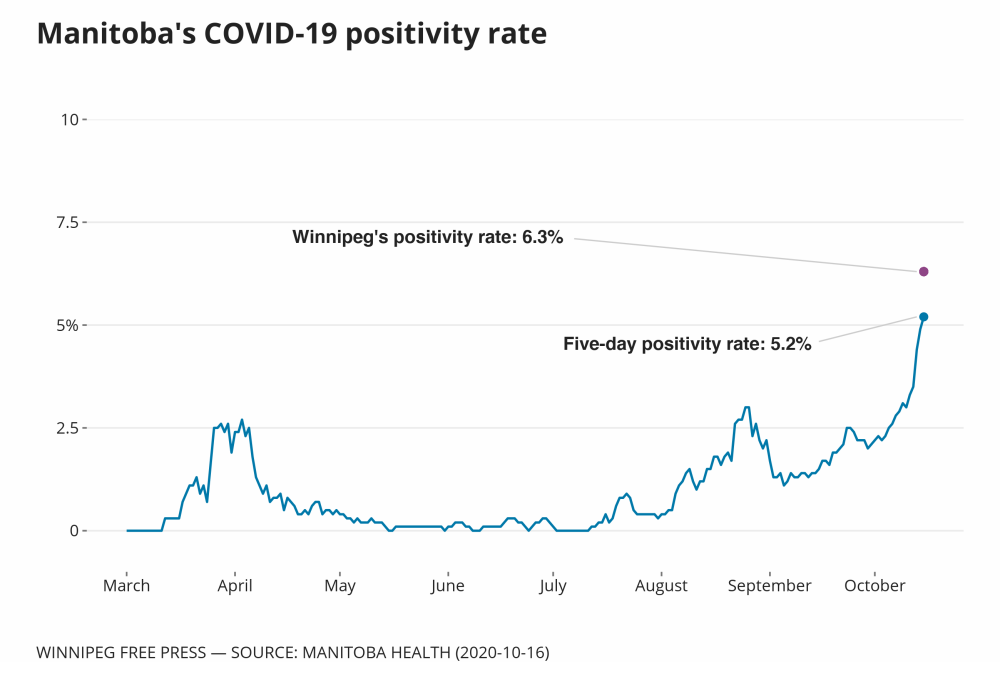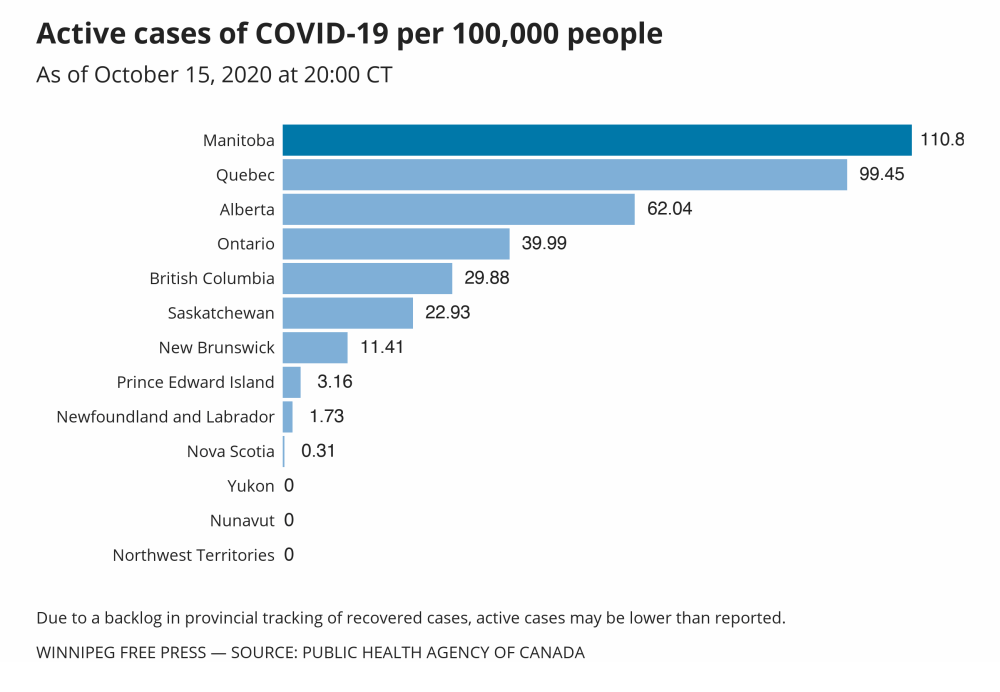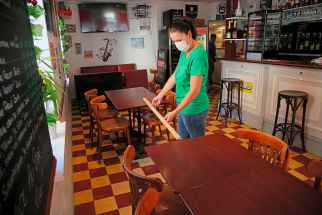Winnipeg COVID-19 test-positivity raises red flags
Read this article for free:
or
Already have an account? Log in here »
To continue reading, please subscribe:
Monthly Digital Subscription
$0 for the first 4 weeks*
- Enjoy unlimited reading on winnipegfreepress.com
- Read the E-Edition, our digital replica newspaper
- Access News Break, our award-winning app
- Play interactive puzzles
*No charge for 4 weeks then price increases to the regular rate of $19.00 plus GST every four weeks. Offer available to new and qualified returning subscribers only. Cancel any time.
Monthly Digital Subscription
$4.75/week*
- Enjoy unlimited reading on winnipegfreepress.com
- Read the E-Edition, our digital replica newspaper
- Access News Break, our award-winning app
- Play interactive puzzles
*Billed as $19 plus GST every four weeks. Cancel any time.
To continue reading, please subscribe:
Add Free Press access to your Brandon Sun subscription for only an additional
$1 for the first 4 weeks*
*Your next subscription payment will increase by $1.00 and you will be charged $16.99 plus GST for four weeks. After four weeks, your payment will increase to $23.99 plus GST every four weeks.
Read unlimited articles for free today:
or
Already have an account? Log in here »
Hey there, time traveller!
This article was published 16/10/2020 (1879 days ago), so information in it may no longer be current.
OTTAWA — Winnipeg has posted one of the worst recorded rates of COVID-19 spread in Canada, exceeding the universal metric for having cases under control.
Dr. Brent Roussin, chief provincial public health officer, started his Friday news conference by noting Manitoba’s test-positivity rate was 5.2 per cent — in Winnipeg, it’s 6.3 per cent.
Public health experts across Canada aim to get that number below three per cent, otherwise it indicates too many people are carrying the novel coronavirus without being tested.
Federally, officials say anything above five per cent is a red flag.
Meanwhile, Manitoba ranked second in the proportion of active cases across Canada.
A test-positivity rate is tabulated based on the rate of COVID-19 tests that come back positive over a five-day period. While testing backlogs can influence the usefulness of the number, it’s generally used to determine just how widespread transmission is within a jurisdiction, and whether enough people are being tested.
The World Health Organization advised in May that jurisdictions implementing temporary restrictions keep them in place until the positivity rate holds below five per cent for at least two weeks.
Federally, Dr. Theresa Tam, chief public health officer of Canada, said in August a positivity rate of five per cent “is a warning sign, for sure” which Ottawa uses, along with the reproduction rate, to tell if jurisdictions are containing spread.
Her assistant, Dr. Howard Njoo, reiterated the importance of the benchmark this month. “Once it’s above five per cent, it’s something that you need to start looking carefully at,” he said.
By comparison, Montreal logged a 7.2 per cent rate as of Wednesday, its most recently published tally. Toronto logged a 3.1 test positivity as of Oct. 10.
Manitoba Health Minister Cameron Friesen said Friday his officials have looked at those numbers in those more dense cities, and is trying to figure out why Winnipeg sits among them.
“We try to keep on top of what’s happening there,” he said. “Our numbers, relatively, are higher now than they were weeks ago.”
In fact, Manitoba’s case numbers are so high, the province has been reporting incorrect information to Ottawa.
A federal dashboard comparing provincial proportions of active cases put Manitoba in the lead Thursday, but only because public health can’t keep up with reporting which cases have recovered.
The province’s Friday update stated there were 1,582 active cases in Manitoba. However, Roussin said, “It’s closer to about 1,000 active cases right now.”
That would put the rate of active cases at 71 per 100,000 people in Manitoba, instead of the 112 reported by the Public Health Agency of Canada. That means Manitoba is still beating both Alberta and the national average for active cases, ranking only behind Quebec.
Roussin said officials are able to reach Manitobans, but are having trouble updating statistics.
“There is no one who’s at home isolating who doesn’t need to be; those people are informed, ‘You no longer have to isolate.’ It’s just a matter of getting that into the system and reported out,” Roussin told the Free Press.
Quebec’s public health authority (INSPQ) told the Free Press it faced a similar backlog on recording its recovered cases in the spring. In late June, it implemented an algorithm that automatically clears cases where people have passed the incubation period without dying or ending up in hospital.
Alberta authorities said they haven’t had such an issue.
Public Health Ontario would only say: “There may be lags in updates of data as health units focus on active cases and contact management to stop the spread of COVID-19 in the community.”
— with files from Danielle Da Silva
dylan.robertson@freepress.mb.ca
History
Updated on Friday, October 16, 2020 7:07 PM CDT: Updates graphics and busts cache







.jpg?h=215)

